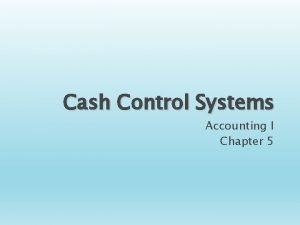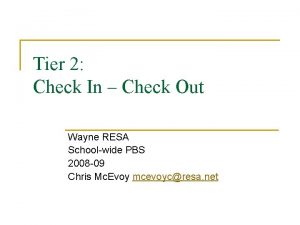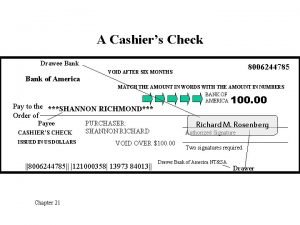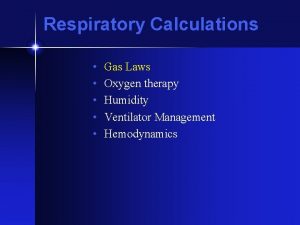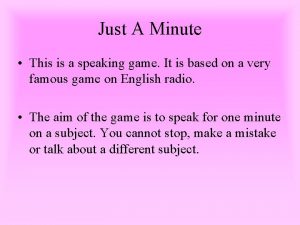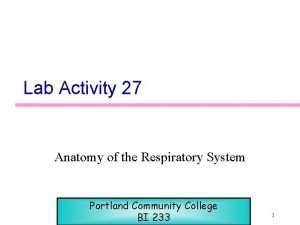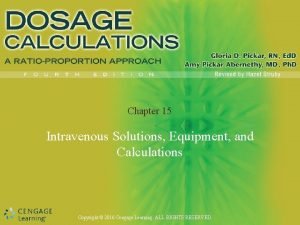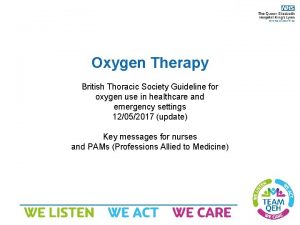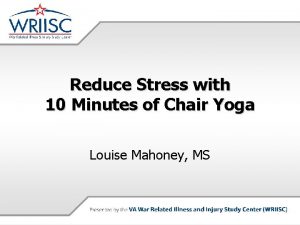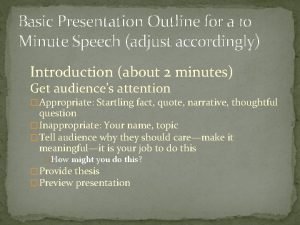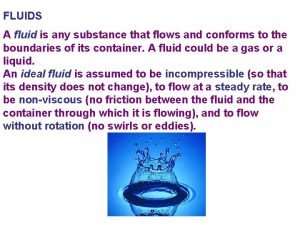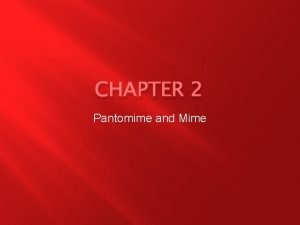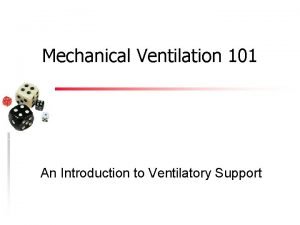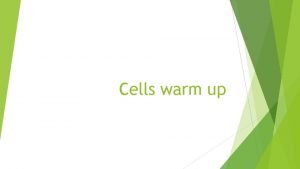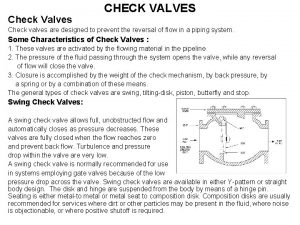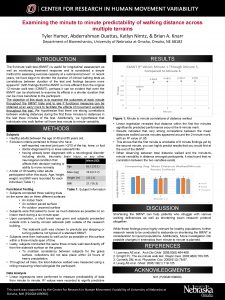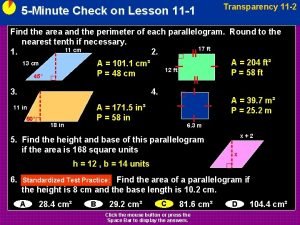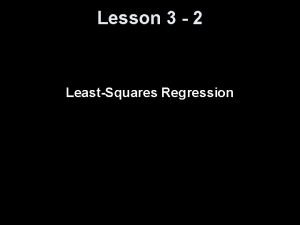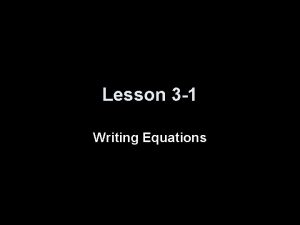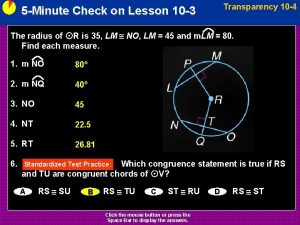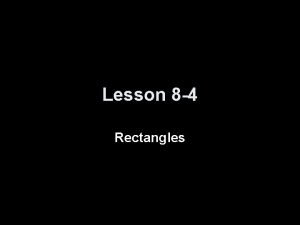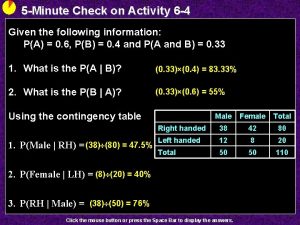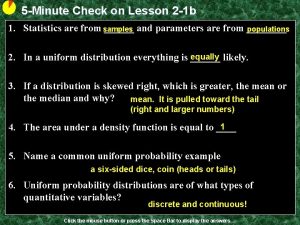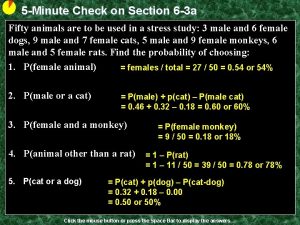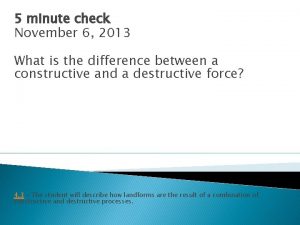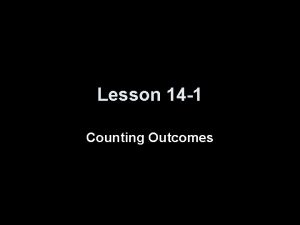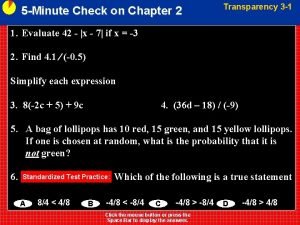5 Minute Check 092616 1 What is the





















































































- Slides: 85

5 Minute Check 09/26/16 1. What is the relationship between an element and a molecule? 2. What is the relationship between an element and an atom? 3. Draw the model of Argon Today’s Standard: MS-PS 1 -2 - Analyze and interpret data on the properties of substances before and after the substances interact to determine if a chemical reaction has occurred.

Taking Care of business � Today we are turning in our projects and offering if anyone would like to present their projects to the class.

Word Wall � We have a new word added to our word wall ◦ Molecule

Unit 3 Date Assignment title Fill in our NAME!!! Then fill in the K and the W Page #

Physical and Chemical Changes � https: //www. youtube. com/watch? v=Qj. J 7 Yug. F U 10

5 Minute Check 09/27/16 1. What are physical properties? 2. What are chemical properties? 3. Can you think of any examples of either? Today’s Standard: MS-PS 1 -2 - Analyze and interpret data on the properties of substances before and after the substances interact to determine if a chemical reaction has occurred.

Taking Care of business � Yesterday we turned in our molecule project if you did not turn it in yesterday you can turn in today for reduced credit. � Yesterday for Unit 3 we started a new table of contents

Unit 3 Date 09/27/16 Assignment title Physical and Chemical Changes Page # 1

Let’s review matter � Every element is unique in some way from all others. � If you know enough about a substance, you can figure out what it is. � If you know what a substance is, you can then know all types of things about it.

Matter �All matter has 2 types of properties: Physical properties and chemical properties.

Physical Property A physical property is a characteristic of a substance that can be observed without changing the substance into another substance. ◦ (You can see it without changing what you’re looking at into something else. )

Physical Properties Physical properties can be extensive or intensive: ◦ Extensive properties depend on the amount of a substance that you have. ◦ Intensive properties don’t depend on how much you have.

Physical Properties Examples of extensive physical properties include: ◦ ◦ Volume Mass Weight Size

Physical Properties Examples of intensive physical properties include: ◦ Density ◦ Melting point ◦ Boiling point

Physical Properties Other physical properties include: ◦ Color ◦ Hardness ◦ Odor ◦ Taste ◦ State of matter ◦ Texture ◦ Luster (shine) ◦ Flexibility ◦ Heat conductivity ◦ Electrical conductivity ◦ Solubility (ability to dissolve in water. ) ◦ Shape ◦ Viscosity ◦ Ductility ◦ Malleability

Physical Properties List as many physical properties as you can for this item:

Physical Change A Physical change is a change in a substance that does not change what the substance is.

Physical Change Examples of physical change include: 1. Change in shape 2. Change in size 3. Change in phase �Melting (solid to liquid) �Boiling (liquid to gas) �Evaporation (liquid to gas) �Condensation (gas to liquid) �Freezing (liquid to solid) �Sublimation (solid to gas) �Deposition (gas to solid)

Physical Change Physical changes might be caused by: • • • Grinding Cutting Crushing Bending Breaking Heating/cooling • (change in phase) • squishing

Physical Change Evidence that a physical change has occurred might include: ◦ ◦ ◦ Change in shape Change in form Change in size Change in phase (This is always a physical change!) Physical changes are usually reversible

Physical Change What could you do to these items to cause a physical change to occur?

Chemical Properties A Chemical property is a characteristic of a substance that can only be observed by changing it into a different substance.

Chemical Properties Examples of chemical properties include: ◦ ◦ ◦ ◦ The ability to burn Ability to tarnish Ability to rust Ability to decompose Ability to react with other chemicals Instability Ability to do acid/base reactions

Chemical Properties List as many chemical properties as you can for this item.

Chemical Change A chemical change is a change in which a substance is changed into a different substance. (You’ve changed what it is. )

Chemical Change � Chemical changes occur when a chemical reaction causes bonds between atoms to break or to form.

Chemical Change There are 5 types of chemical reactions that cause chemical changes to occur.

Chemical change 1 - Composition reactions ◦ Two things come together to form something new ◦ A + B = AB ◦ 2 H 2 + O 2 2 H 2 O

Chemical change 2 - Decomposition reactions ◦ 1 thing breaks apart to form 2 or more things. ◦ AB = A + B ◦ 2 H 2 O 2 H 2 + O 2

Chemical change 3 - Single replacement reactions ◦ One atom replaces another atom ◦ A + BC = AC + B or A + BC = AB + C ◦ Mg + 2 HCl H 2 + Mg. Cl 2

Chemical Change 4 - Double replacement reactions ◦ Two chemicals switch places ◦ AX + BY = AY + BX ◦ 2 KI + Pb(NO 3)2 Pb. I 2 + 2 KNO 3

Chemical Change 5 - Combustion reaction ◦ A substance combines with oxygen and releases energy. ◦ C 3 H 8 (propane) + 5 O 2 3 CO 2 + 4 H 2 O

Chemical Change Evidence that a chemical change has occurred might include: ◦ A color change ◦ An odor change ◦ Formation of a precipitate (you mix two liquids and make a solid) ◦ Gas is formed (bubbles) ◦ Changes in physical properties.

Chemical Change During a chemical change energy can be released in the form of: ◦ Heat ◦ Light

Chemical change When a chemical change occurs, energy is either released or absorbed.

Chemical change A chemical reaction that releases energy in the form of heat is called exothermic. ◦ Heat comes OUT �Exo = out �Thermic = heat ◦ It will feel HOT.

Chemical change A chemical reaction that absorbs energy in the form of heat is called endothermic. ◦ Heat goes IN �Endo = in �Thermic = heat ◦ It will feel COLD

Chemical and physical properties So what?

Chemical and physical properties – So what? � Titanium is very strong and doesn’t rust, so it is often used in jet engines. � Titanium is also nonallergenic. This, combined with the fact that it is rust proof makes it great for artificial joints as well as piercings.

Chemical and physical properties – So what? � Tungsten is usually used as the filament in lightbulbs because it has the highest melting point of any metal. � It glows red hot when electricity runs through it, and it gives off both heat and light.

Chemical and physical properties – So what? � Vanadium is heavier and harder than titanium, so mixing a tiny bit of vanadium with steel can make cheap tools that are still very strong.

Chemical and physical properties – So what? � Helium is almost completely nonreactive (inert). � It is lighter than air, so it’s great for floating balloons (or making funny voices. ) � When electricity runs through helium, it glows a creamy pale peach color.

Chemical and physical properties – So what? � In 1943, all US pennies were made of zinc plated steel because copper was being used in the war. The pennies had to be coated with zinc because steel will rust, but zinc won’t.

Chemical and physical properties – So what? � Sulfur smells awful. Rotten eggs, onions, and garlic all have sulfur in them. Stink bombs use sulfur to create a bad smell. � Sulfur is also flammable, and it is one of the 3 main ingredients in gun powder.

Chemical and physical properties – So what? � Chromium is famous for its intense luster. Chrome plated tools, jewlery, silverware, or car parts are very popular.

Physical and Chemical Changes video � https: //www. youtube. com/watch? v=37 pir 0 ej_SE

5 Minute Check 09/28/16 1. What is a physical change? 2. What is a chemical change? 3. Can you think of any examples of either? Today’s Standard: MS-PS 1 -2 - Analyze and interpret data on the properties of substances before and after the substances interact to determine if a chemical reaction has occurred.

Taking Care of business � If you did not turn in your molecule report please turn it in late

Let’s review from yesterday

Physical Change Physical change: a change that occurs that does not change the identity of the substance ◦ ◦ Melting ice Freezing Kool-aid Tearing paper Boiling water

Chemical Changes � Chemical change: a change that occurs causing the identity of the substance to change ◦ Burning paper ◦ Digesting food ◦ Electrolysis of water �A chemical change is called a chemical reaction

Chemical Changes � Indicators of a chemical change: �Evolution of light �Evolution of heat �Evolution of a gas �Color change �Formation of a precipitate


Answer the following 10 questions using: A for Physical Change And B for Chemical Change

1. A. Physical Change B. Chemical Change Rusting nails

2. A. Physical Change B. Chemical Change Effervescent tablet

3. A. Physical Change B. Chemical Change Cut paper

4. A. Physical Change B. Chemical Change Vinegar and Baking soda

5. A. Physical Change B. Chemical Change Salt and water

6. A. Physical Change B. Chemical Change Broken glass

7. A. Physical Change B. Chemical Change Burning wood

8. A. Physical Change B. Chemical Change Ice melting

9. A. Physical Change B. Chemical Change Removing iron filings from a mixture

10. A. Physical Change B. Chemical Change Boiling water

1. A. Physical Change B. Chemical Change Answer B. Chemical Change Rusting nails

2. A. Physical Change B. Chemical Change Answer B. Chemical Change Effervescent tablet

3. A. Physical Change B. Chemical Change Answer A. Physical Change Cut paper

4. A. Physical Change B. Chemical Change Answer B. Chemical Change Vinegar and Baking soda

5. A. Physical Change B. Chemical Change Answer A. Physical Change Salt and water

6. A. Physical Change B. Chemical Change Answer A. Physical Change Broken glass

7. A. Physical Change B. Chemical Change Answer B. Chemical Change Burning wood

8. A. Physical Change B. Chemical Change Answer A. Physical Change Ice melting

9. A. Physical Change B. Chemical Change Answer A. Physical Change Removing iron filings from a mixture

10. A. Physical Change B. Chemical Change Answer A. Physical Change Boiling water

Unit 3 Date Assignment title Page # 09/27/16 Physical and Chemical Changes 1 09/28/16 Mystery Powder Investigation (3 Pages) 2

ENGAGE Imagine that you are a crime scene investigator working with the local police department. A suspicious white powder has been found at a local school. This powder may be something harmless, like sugar, or something dangerous, like a chemical agent or drugs. It is your job to identify the substance. 1. What are some examples of physical properties that you could measure in order to identify the powder? 2. What are some examples of chemical properties that you could measure in order to identify the powder?

Explore Investigation Question: Can the way a substance reacts chemically, along with its physical properties, allow you to identify what it is when compared to other similar looking substances?

Appearance Procedure 1. Place a very small amount of the baking soda on a piece of black paper. Look at it using the magnifying lens. Record what you see in Table 1. 2. Repeat this procedure with each of the powders, individually. Remember to record your observations right away so you do not forget what you observed.

5 Minute Check 09/29/16 Identify the following as either a Physical Change or a Chemical Change. 1. Cutting paper 2. Ice melting 3. Toast Burning 4. Sawing Wood 5. Metal Rusting 6. Disappearing Puddle 7. Candle Burning 8. Dry Ice Today’s Standard: MS-PS 1 -2 - Analyze and interpret data on the properties of substances before and after the substances interact to determine if a chemical reaction has occurred.

Taking Care of business � Let’s review from yesterday ◦ We started our lab by examining a variety of different powders. As we looked at each sample we recorded the physical properties for each.

Reactions Procedure 3. Measure exactly 1 tablespoon of baking soda and place the spoonful into one of the compartments of the tray. 4. Separate the baking soda into 3 piles within its compartment. 5. Add several drops of water (3– 5 drops) to the first pile of baking soda. Observe any reaction and record your observations in Table 1 immediately. 6. Add several drops of vinegar (3– 5 drops) to the second pile of baking soda. Observe any reaction and record your observations in Table 1 immediately. 7. Add several drops of iodine solution (3– 5 drops) to the last pile of baking soda. Observe any reaction and record your observations in Table 1 immediately. 8. Repeat steps 3– 6 with the remaining powders, making sure to place each powder in a separate compartment. Remember to record your observations right away so you do not forget what you observed.

5 Minute Check 09/30/16 1. What is the difference between a physical property and a chemical property? 2. Why do we care what an objects physical and chemical properties are? Today’s Standard: MS-PS 1 -2 - Analyze and interpret data on the properties of substances before and after the substances interact to determine if a chemical reaction has occurred.

Taking Care of Business � Yesterday we tested each powder with a different liquid to see its solubility and recorded what reactions occurred.

Solubility Procedure 9. Measure enough baking soda into a 50 m. L beaker to cover the bottom of the beaker. 10. Measure out 25 m. L of water using the graduated cylinder and pour it into the beaker. 11. Using a stir stick, stir the mixture. Observe the solution and record your observations in Table 1. 12. Thoroughly wash and DRY your breaker and stir stick to reuse it for each of the powders. 13. Repeat steps 8– 10 with the remaining powders, placing each powder in a beaker. Remember to record your observations right away so you do not forget what you observed.

Explain Use the data gathered above and information from previous science lessons to answer the following questions. 1. Which of the procedures measured physical properties? (list all) 2. Which of the procedures measured chemical properties? (list all) 3. Which of the reaction tests resulted in a chemical change occurring to the substances involved? (list all) 4. Choose two of the reactions from question 3 and explain how you know that a chemical change occurred. What were the clues that demonstrated to you that there was a chemical change?
 1hour in seconds
1hour in seconds Advantages and disadvantages of scan line fill algorithm
Advantages and disadvantages of scan line fill algorithm Endorsement
Endorsement Check in check out
Check in check out Checkin checkout system
Checkin checkout system Check my progress vocabulary check
Check my progress vocabulary check Check in check out system
Check in check out system Check in and check out intervention
Check in and check out intervention Behavior check in check out sheet
Behavior check in check out sheet Cashiers check bank of america
Cashiers check bank of america The fan blade is speeding up. what are the signs of
The fan blade is speeding up. what are the signs of Behavior check in check out sheet
Behavior check in check out sheet Các môn thể thao bắt đầu bằng tiếng bóng
Các môn thể thao bắt đầu bằng tiếng bóng Frameset trong html5
Frameset trong html5 Khi nào hổ mẹ dạy hổ con săn mồi
Khi nào hổ mẹ dạy hổ con săn mồi điện thế nghỉ
điện thế nghỉ Biện pháp chống mỏi cơ
Biện pháp chống mỏi cơ Trời xanh đây là của chúng ta thể thơ
Trời xanh đây là của chúng ta thể thơ Gấu đi như thế nào
Gấu đi như thế nào Thiếu nhi thế giới liên hoan
Thiếu nhi thế giới liên hoan So nguyen to
So nguyen to Phối cảnh
Phối cảnh Các châu lục và đại dương trên thế giới
Các châu lục và đại dương trên thế giới Một số thể thơ truyền thống
Một số thể thơ truyền thống Thế nào là hệ số cao nhất
Thế nào là hệ số cao nhất Bổ thể
Bổ thể Sơ đồ cơ thể người
Sơ đồ cơ thể người Tư thế ngồi viết
Tư thế ngồi viết đặc điểm cơ thể của người tối cổ
đặc điểm cơ thể của người tối cổ Cách giải mật thư tọa độ
Cách giải mật thư tọa độ Chụp phim tư thế worms-breton
Chụp phim tư thế worms-breton ưu thế lai là gì
ưu thế lai là gì Thẻ vin
Thẻ vin Thơ thất ngôn tứ tuyệt đường luật
Thơ thất ngôn tứ tuyệt đường luật Cái miệng bé xinh thế chỉ nói điều hay thôi
Cái miệng bé xinh thế chỉ nói điều hay thôi Các châu lục và đại dương trên thế giới
Các châu lục và đại dương trên thế giới Từ ngữ thể hiện lòng nhân hậu
Từ ngữ thể hiện lòng nhân hậu Diễn thế sinh thái là
Diễn thế sinh thái là Tư thế ngồi viết
Tư thế ngồi viết V cc
V cc Làm thế nào để 102-1=99
Làm thế nào để 102-1=99 Alleluia hat len nguoi oi
Alleluia hat len nguoi oi Hát kết hợp bộ gõ cơ thể
Hát kết hợp bộ gõ cơ thể Khi nào hổ con có thể sống độc lập
Khi nào hổ con có thể sống độc lập đại từ thay thế
đại từ thay thế Vẽ hình chiếu vuông góc của vật thể sau
Vẽ hình chiếu vuông góc của vật thể sau Quá trình desamine hóa có thể tạo ra
Quá trình desamine hóa có thể tạo ra Cong thức tính động năng
Cong thức tính động năng Thế nào là mạng điện lắp đặt kiểu nổi
Thế nào là mạng điện lắp đặt kiểu nổi Tỉ lệ cơ thể trẻ em
Tỉ lệ cơ thể trẻ em Lời thề hippocrates
Lời thề hippocrates Dạng đột biến một nhiễm là
Dạng đột biến một nhiễm là Vẽ hình chiếu đứng bằng cạnh của vật thể
Vẽ hình chiếu đứng bằng cạnh của vật thể độ dài liên kết
độ dài liên kết Dynamic compliance
Dynamic compliance Just a minute game
Just a minute game Telling the time
Telling the time Three minute review
Three minute review What drives people
What drives people Nnn sissy
Nnn sissy 90 minute reading block examples
90 minute reading block examples Draw the structure of a part of lung showing alveoli.
Draw the structure of a part of lung showing alveoli. 2 minute paper
2 minute paper 15 minute presentation
15 minute presentation Professional curiosity munro
Professional curiosity munro Cengage infuse
Cengage infuse 3 minute testimony
3 minute testimony Wtf per minute
Wtf per minute Talk a mile a minute
Talk a mile a minute Minute to win it iron man
Minute to win it iron man Oxygen liters per minute chart
Oxygen liters per minute chart 15 minute math
15 minute math 45 minute basketball workout
45 minute basketball workout 15 minute office workout
15 minute office workout The liberator of latin america worksheet
The liberator of latin america worksheet Cram last minute
Cram last minute 10 minute chair yoga for seniors
10 minute chair yoga for seniors Last minute risk assessment
Last minute risk assessment 10 min speech
10 min speech 5 minute settlement
5 minute settlement Six-minute walk test 500m
Six-minute walk test 500m A 60 kg rectangular box open at the top
A 60 kg rectangular box open at the top Pantomime and mime
Pantomime and mime Ventilators 101
Ventilators 101 Three minute review
Three minute review Three minute review
Three minute review


